
The "Alfonso" was named after His Most
Catholic Majesty Alfonso XIII, the last Bourbon
King of Spain...
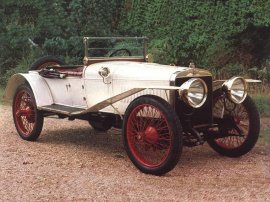
Like most cars, the Alfonso would evolve over the
years, the original wooden guards being replaced
by the normal metal variety, and the inclusion
of over-sized headlights...
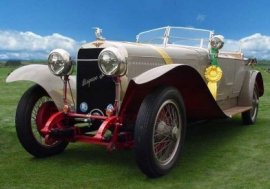
The first of the entirely French-conceived Hispano
Suiza's was the Marc Birkigt designed H6B of 1919...
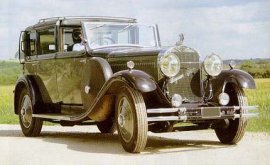
Typical of the day, there was a range of body styles
available for the one chassis...
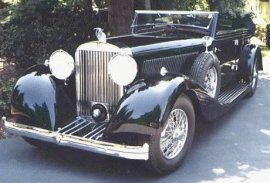
In 1924 Woolf Barnato (later to become a famous
'Bentley Boy') took a Boulogne to Brooklands where
he would notch up an average speed of 92.2mph (148kmh)
over a 300 mile journey...

During the 1930's the French factory would concentrate
on armaments, rather than this beautiful Type 68...
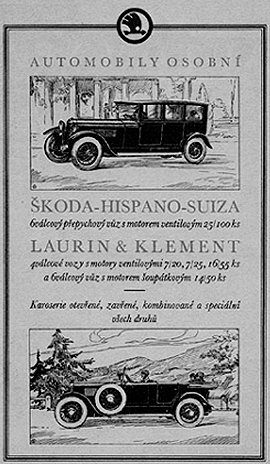
Hispano Suiza's would be built both in Argentina,
and in Czechoslovakia by Skoda... |
Undeniably one of the most unique names of any car
manufacturer, the once famous marque had its name derived
from two countries - Spain, where it entered production
in 1904, and Switzerland where its designer Marc Birkigt
was born.
The company was founded in the early part
of last century, and in the initial years of production
there was nothing to make a Hispano-Suiza stand out
from dozens of other cars being made at that time, particularly
when production in Spain was on a very small scale.
But King Alfonso XIII
of Spain was keen to help the fledgling manufacturer
achieve success, and several of the more luxurious types
were to find their way into his garage. This in turn
would inspire other young Spaniards to purchase, and
race, a Hispano-Suiza.
In 1910 the marque would notch
up a win at the French Coupe de L’Auto race, and
following the victory the company decided to name a
sports touring version of the car after King Alfonso.
The 'Alfonso' Hispano-Suiza would then evolve over
the next two years; the car was a beautifully proportioned
machine, usually fitted with a 3620cc engine good for
64bhp at 2300rpm.
Because of its side-valve 'T-head'
arrangement and very long stroke (80mm bore, 180mm stroke)
configuration, it had tremendous low-speed torque. At
first a three-speed transmission was standard, but this
was later replaced by a four speed transmission, the
latter transmission making the Alfonso good for around
75mph (120kmh).
In 1911 the company decided to expand beyond Spain,
and so opened a factory at Levallois-Perret, close to
the lucrative markets of Paris, France.
Following the
outbreak of World War I, an aero-engine factory was
established at Bois-Colombes, and after the war this
became the home of the most exotic Hispano-Suiza cars.
Meanwhile the Spanish factory continued to make cars,
concentrating on more 'basic' versions and commercial
vehicles. They also assembled some of the French Hispanos
for wealthier Spanish customers. But it was at the French
factory that the desirable Hispano Suiza’s were
being built.
The first of the entirely French-conceived
types was the Marc Birkigt designed H6B of 1919. By
this time Birkigt had spent much time in and around
the French capital, and he had gained an insight into
what wealthy Parisians expected in a motor car.
The H6B was therefore intended as a fast, luxurious
and expensive machine, good for a top speed of around
80mph despite even the heaviest saloon car coachwork.
To achieve this, Birkigt developed an advanced 6597cc
six-cylinder engine, which was effectively half of an
intended military V12 aero-engine. The cylinder block
was in aluminium, with steel liners and overhead cam.
Peak power was 135bhp at 2600rpm.
This substantial weight
and performance of the car was kept firmly in check
by the first successful use of four-wheel brakes with
a mechanical servo. This was mechanically so elegant
and effective that Rolls-Royce soon acquired a licence
to use it on their own cars.
Versions of the H6B (or 37.2hp model as it was sometimes
known), performed well in motor sport; the short-wheelbase
model was named 'Monza' after a victory at that circuit
in 1922.
Dubonnet and Bablot would soon have a victory
in the “Boillot Cup” race at Boulogne, and
then Garnier and Boyriven would take out the “Coupe
de Boulogne”. Birkigt decided that the marque
needed a true sports car version, and so in 1924 the
naturally named “Boulogne” or H6C Sport
was launched.
Compared with the first H6B, the Boulogne had an increased
cylinder bore (of 110mm in place of 100mm), but retained
the same 140mm stroke, the capacity therefore becoming
7983cc.
It had a higher compression ratio and, in the
case of high-lift camshaft models, the engine was good
for more than 200bhp.
In 1924 Woolf Barnato (later to become a famous 'Bentley
Boy') took a Boulogne to Brooklands where he would notch
up an average speed of 92.2mph (148kmh) over a 300 mile
journey.
That effort would earn Barnato numerous international
endurance records. The same year, another Boulogne would
win a £5000 wager against Stutz by averaging 70mph
(112.6kmh) for 24 hours.
The top speeds of the standard
model were about 110mph (177kmh), and by the standards
of the day the handling, braking and road behavior were
all superb.
H6 types would continue to be built into the 1930s,
alongside the magnificent French-built V12 models.
These were large, fast luxury cars for the very rich,
and although a few had open coachwork, most were not
sporting cars, despite possessing all the usual virtues
of this splendid marque.
The H6 however was starting
to show its age, and so in 1931 production of the model
ended.
Only 16 genuine H6C Boulognes were ever built,
nine of them specifically for racing, but many “standard”
H6B’s were fitted with the same type of 8 litre
engine, and therefore could achieve nearly everything
offered by the Boulognes, though the handling on the
longer wheelbase versions was never as good.
As the 1930s progressed, the French factory became
increasingly involved in military rearmament, such that
production of cars became a sideline. In 1938 it ceased
completely, although it continued, in Spain, into the
war years.
In total, less than 3000 Hispano-Suizas were
built in France, this figure including a few cheaper
models made as a result of the takeover of Ballot in
1930. Surprisingly, a few of the more exotic types were
made under license by Skoda of Czechoslovakia, and by
an Argentinian firm until 1942.
The Hispano-Suiza is now chiefly remembered as a luxury
car for enthusiast owner-drivers, rather than for tycoons
leaving the driving chore to their chauffeurs. By these
exalted standards, the Alfonso and Boulogne models were
truly exceptional.
Like Bugattis, they combined a. remarkable
blend of engineering excellence and styling harmony.
Marc Birkigt himself finally retired from aero-engine
design in 1950, and the French end of his firm then
combined with Bugatti.
Also see:
Hispano-Suiza Car Reviews
Hispano-Suiza H6
Lost Marques: Hispano-Suiza (USA Edition) |



